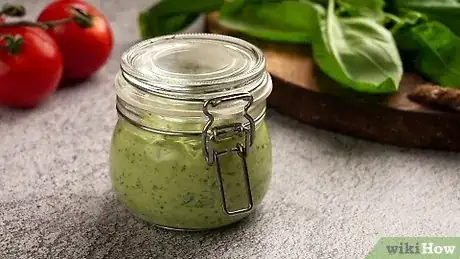This article was co-authored by Jerran Boyer. Chef Jerran Boyer is a Nutrition-Focused Professional Chef and the CEO of Health Nut Chefs. Chef Jerran has over 20 years of experience as a private chef. She and her team specialize in providing healthy, fresh-prepared meals designed with each client’s taste and dietary needs in mind. She and her team offer both personal, part-time chef services and private, full-time chef services in New York, New Jersey, and the Los Angeles area. Chef Jerran received her BS in Business Administration from the University of South Florida, a degree in Culinary Arts from Florida Culinary Institute, and a Plant-Based Nutrition Certificate through Cornell University.
This article has been viewed 2,960 times.
Pesto’s famous zestiness, simplicity, and versatility make this green sauce a go-to for any occasion, from casual brunch to the classiest of dinner parties. You might think there’s not much else you can do to improve on this seemingly-perfect food, but you can step up your sauce game in just a few easy moves and give your pesto a creaminess on par with alfredo sauce!
Ingredients
- 2 cups (140 g) of fresh basil, packed
- ½ cup (70 g) of pine nuts
- ½ cup (50 g) of grated parmesan cheese
- 2–3 cloves of garlic
- 2 teaspoons (9.9 mL) of lemon juice, optional
- 1⁄2 cup (120 mL) of extra virgin olive oil
- .5 cups (120 mL) of heavy cream
- Salt and pepper, to taste
Steps
Creamy Pesto Sauce Recipe
-
1Combine all ingredients in a blender or food processor except for your heavy cream. Mix 2 cups (140 g) of fresh basil, ½ cup (70 g) of pine nuts, ½ cup (50 g) of grated parmesan cheese, 2–3 cloves of garlic, 2 teaspoons (9.9 mL) of lemon juice, and 1⁄2 cup (120 mL) of extra virgin olive oil. Pulse a few times until you have a paste-like mixture.[1]
- No pine nuts on hand? You can substitute walnuts, almonds, or pistachios.
- For a nut-free recipe, substitute sunflower seeds for pine nuts.[2]
-
2Add 1⁄2 cup (120 mL) of heavy cream. Pour your heavy cream into the blender or food processor, and pulse until your pesto has a creamy, velvety texture.[3]
- You can make your pesto thinner by using less cream, or by substituting half-and-half for heavy cream.
- Creamy pesto can be vegan-friendly with just a few alterations. Simply switch out your heavy cream for cashew milk, and substitute your parmesan with vegan parmesan or with ¼ cup (85 g) of nutritional yeast.[4]
Advertisement -
3Taste-test your pesto. Season with salt and pepper as needed, and you’re finished![5]
- Pesto is extremely versatile. You can use your creamy pesto as a salad dressing, vegetable dip, or pizza sauce.
- Creamy pesto is naturally gluten-free. For gluten-free dishes to serve with your pesto, try celery, gluten-free toast, or zucchini noodles, aka zoodles.
- Creamy pesto is keto-friendly. This rich and cheesy sauce is high in fat, but low on carbs, making it an ideal snack for keto dieters.[6]
Creamy Pesto Storage
-
1Store your pesto in a small, sealed container. Creamy pesto browns easily when it is exposed to air, so minimizing your sauce’s exposure will help preserve its freshness.[7]
- You can also press plastic wrap directly onto the surface of the pesto before sealing it in its container to limit its exposure to air.[8]
- Another way to preserve your pesto’s freshness is to drizzle a thin layer of olive oil on top of your sauce before sealing it.[9]
- To deactivate the enzyme that causes browning, blanch your basil before making your pesto: place the basil in boiling water for 30 seconds, briefly shock it in ice water, then dry the basil. [10]
-
2Refrigerate your pesto. You can keep your pesto refrigerated for up to a week.[11]
-
3Freeze your pesto as needed. It’s not ideal to freeze your creamy pesto, as the texture may change upon thawing. However, if you must freeze your pesto, you can always add the heavy cream in after you have thawed your sauce out.[12]
- The most convenient way to freeze pesto is in an ice cube trays. Spoon it into an ice cube trays until frozen, then remove pesto cubes and store them in an airtight container.
- This way you won’t need to thaw all pesto at once, but only take the amount needed for each recipe.
References
- ↑ https://www.barleyandsage.com/homemade-creamy-basil-pesto/#recipe
- ↑ https://tastyoven.com/creamy-pesto-sauce/
- ↑ https://www.barleyandsage.com/homemade-creamy-basil-pesto/#recipe
- ↑ https://www.barleyandsage.com/homemade-creamy-basil-pesto/#recipe
- ↑ https://www.barleyandsage.com/homemade-creamy-basil-pesto/#recipe
- ↑ https://www.barleyandsage.com/homemade-creamy-basil-pesto/#recipe
- ↑ https://tastyoven.com/creamy-pesto-sauce/
- ↑ https://www.mashed.com/257128/this-simple-trick-will-keep-your-pesto-from-turning-brown/
- ↑ https://www.mashed.com/257128/this-simple-trick-will-keep-your-pesto-from-turning-brown/





















































